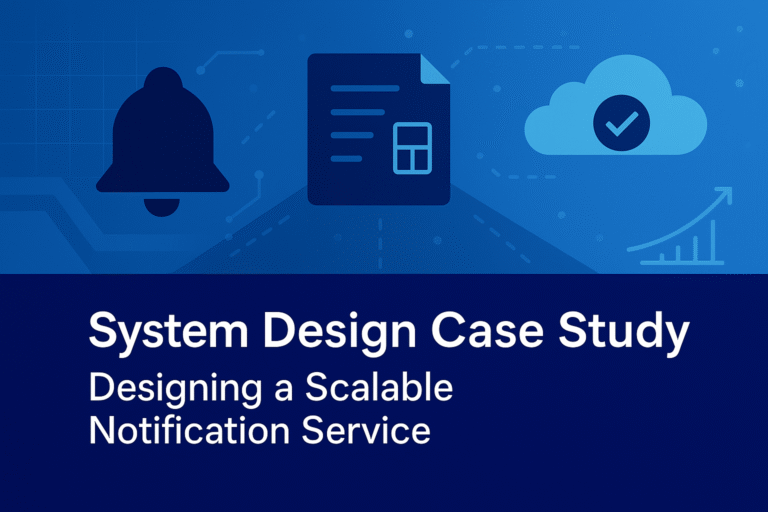Introduction
Stateful and stateless architectures represent two distinct paradigms in system design, each with significant implications for scalability, complexity, and operational efficiency. Stateful architecture maintains client session data or application state on the server, while stateless architecture treats each request independently, storing no session-specific information on the server. This document provides a detailed comparison of these approaches, exploring their definitions, characteristics, advantages, challenges, and impact on system design. Understanding these models is essential for architects and engineers, particularly in the context of distributed systems and scalability considerations during design interviews.
Definitions and Core Characteristics
Stateful Architecture
In a stateful architecture, the server retains information about the client’s previous interactions or session state across multiple requests. This state might include user preferences, transaction history, or session identifiers, stored in server memory, databases, or session management systems. For example, an online shopping cart that remembers items across page visits relies on the server maintaining the cart’s state. The server must track and update this state, ensuring consistency as the client interacts with the application. This model is prevalent in legacy systems or applications requiring persistent context, such as banking platforms where transaction sequences must be preserved.
Stateless Architecture
Conversely, a stateless architecture does not retain client-specific state between requests. Each request from a client contains all necessary information to complete the operation, often including session data or tokens passed in headers or payloads. A classic example is a RESTful API, where a GET request for user data includes an authentication token, and the server processes it without reference to prior requests. This approach relies on clients or external storage (e.g., databases, caches) to manage state, if needed. Stateless designs are foundational to modern web services, enabling scalability through independence of server instances.
Comparative Analysis
Impact on Scalability
Stateful Architecture: Scalability is a significant challenge in stateful systems. Since the server maintains session state, requests must be routed to the same server that initiated the session, limiting the ability to distribute load across multiple servers. Load balancers must employ sticky sessions (session affinity) to ensure consistency, which can create bottlenecks as traffic grows. For instance, adding a new server does not immediately alleviate load if all clients are tied to existing stateful nodes. This constraint often necessitates vertical scaling (upgrading server capacity) or complex state replication across servers, increasing infrastructure costs and complexity.
Stateless Architecture: Stateless designs excel in scalability. Because each request is self-contained, requests can be routed to any available server, allowing horizontal scaling with additional nodes. Load balancers can distribute traffic evenly without session affinity, optimizing resource utilization. For example, a stateless web service can scale by adding more instances behind a load balancer during peak traffic, such as a holiday sale on an e-commerce site. This flexibility supports cloud-native architectures, where auto-scaling groups dynamically adjust capacity based on demand, making stateless systems highly adaptable to varying workloads.
Impact on System Complexity
Stateful Architecture: The need to manage and synchronize state introduces significant complexity. Servers must implement session management, handle state persistence (e.g., in-memory stores or databases), and ensure state consistency across failures or restarts. This can lead to intricate logic for state migration or failover, as seen in multi-server environments where session data must be replicated. For example, a stateful banking application must ensure that a partially completed transaction is not lost during a server crash, requiring robust recovery mechanisms. This complexity increases development time, testing efforts, and the risk of state-related bugs.
Stateless Architecture: Stateless systems reduce server-side complexity by offloading state management to clients or external systems. Each request is processed in isolation, eliminating the need for server-side session tracking or state synchronization. However, this shifts complexity to the client or external storage layer, such as requiring clients to maintain session tokens or integrating with distributed caches like Redis. For instance, a stateless API might rely on JSON Web Tokens (JWT) for authentication, placing the burden on the client to include the token in every request. While simpler on the server, ensuring secure and efficient state management at the client level requires careful design.
Advantages
Stateful Architecture: Offers a seamless user experience by preserving context across interactions. This is advantageous for applications requiring continuity, such as multi-step forms or real-time games where player progress must be tracked. The server can optimize responses based on known state, potentially reducing the data exchanged per request. In scenarios like customer support systems, maintaining session state allows agents to resume conversations without re-authentication.
Stateless Architecture: Provides robustness and simplicity in distributed environments. The independence of requests enhances fault tolerance, as a server failure does not disrupt ongoing sessions if another server can handle the next request. This model aligns with REST principles, promoting interoperability and ease of integration with diverse clients. It also simplifies server maintenance, as instances can be replaced or upgraded without affecting user sessions.
Challenges
Stateful Architecture: The primary challenge is the dependency on server state, which can lead to single points of failure or scalability limits. State synchronization across a server cluster is resource-intensive and prone to inconsistencies, especially in high-availability setups. Additionally, managing state increases memory usage and can complicate load balancing strategies, requiring significant overhead for session persistence.
Stateless Architecture: The challenge lies in managing state externally, which can introduce latency if clients must fetch state from a database or cache for each request. Security becomes critical, as clients must securely handle and transmit state data (e.g., tokens), risking exposure if not properly encrypted. Furthermore, applications with complex workflows may require additional design effort to simulate stateful behavior, such as using event sourcing or temporal data stores.
Design Considerations and Trade-Offs
Use Case Suitability
Stateful architecture is suitable for applications where context is critical and session duration is short or predictable, such as online banking transactions or interactive tutorials. The ability to maintain state simplifies client logic but requires careful planning for scalability. In online banking, for instance, a stateful server can track a multi-step fund transfer process, ensuring each step builds on the previous one without requiring the client to resubmit data. This reduces client-side complexity and enhances user experience by maintaining a seamless workflow. However, scalability planning is crucial, as the server must handle state replication or session affinity, which can limit the ability to add servers dynamically during peak usage, such as end-of-month payroll processing.
Stateless architecture is ideal for high-traffic, distributed systems like content delivery networks or microservices, where scalability and resilience outweigh the need for server-side context. For example, a video streaming service benefits from stateless design to handle millions of concurrent users, offloading user preferences to a separate profile service. This approach allows the service to scale horizontally by adding server instances, with load balancers distributing requests without concern for session continuity. The trade-off is that clients must manage state—such as storing a session token or fetching preferences from the profile service—potentially increasing latency or requiring robust client-side logic. In high-traffic scenarios like live sports streaming, this design ensures availability, but architects must optimize data retrieval to minimize delays.
Additional use cases highlight these distinctions. Stateful designs suit real-time gaming, where a server tracks player positions and game state across moves, simplifying client design but necessitating state synchronization across a server cluster. Stateless designs excel in e-commerce platforms during sales events, where stateless APIs handle product searches, while a separate stateful component manages checkout sessions. In interviews, candidates should evaluate use case requirements—such as transaction continuity versus traffic volume—and justify the chosen architecture with specific examples, demonstrating an ability to balance trade-offs.
Implementation Strategies
For stateful systems, strategies include using in-memory session stores (e.g., Memcached) or database-backed sessions with replication to ensure availability. In-memory stores like Memcached offer low-latency access to session data, ideal for applications with frequent state updates, such as a multi-player game server. However, they require careful memory management and failover strategies, such as replicating data across nodes to prevent loss during server failures. Database-backed sessions, using systems like PostgreSQL with replication, provide durability but introduce latency due to disk I/O. Load balancers must support sticky sessions to route requests to the correct server, and failover mechanisms—such as warm standby servers—should preserve state during transitions, ensuring minimal disruption. For example, a stateful e-commerce checkout system might use replicated in-memory stores to maintain cart data, with failover servers taking over if a primary node fails.
In stateless systems, implementing token-based authentication (e.g., OAuth) or leveraging client-side storage (e.g., localStorage) shifts state management. OAuth tokens, such as JSON Web Tokens (JWT), allow clients to include authentication and session data in each request, enabling servers to remain agnostic to prior interactions. This requires secure token generation and validation, often with short expiration times and refresh mechanisms to mitigate security risks. Client-side storage, like localStorage, can cache user preferences or session IDs, reducing server calls, but it necessitates encryption to protect sensitive data. Caching layers, such as Redis, can reduce database load by storing frequently accessed data, while asynchronous communication (e.g., WebSockets) enhances responsiveness for state-like interactions, such as real-time notifications. For instance, a stateless news app might use OAuth tokens for authentication and WebSockets for live updates, optimizing performance while offloading state to the client.
Implementation also involves trade-offs. Stateful strategies prioritize consistency but increase server overhead, requiring robust monitoring to detect state inconsistencies. Stateless strategies enhance scalability but demand secure client-side handling, necessitating additional testing for edge cases like token expiration. In interviews, candidates should outline a step-by-step implementation plan—e.g., configuring Memcached replication for stateful systems or setting up OAuth flows for stateless ones—and discuss how these choices align with system goals.
Hybrid Approaches
Many modern systems adopt hybrid models, combining stateful and stateless elements. For instance, a stateless API might handle authentication and data retrieval, while a stateful component manages real-time chat sessions. This approach balances scalability with functionality, as the stateless API can scale horizontally to serve millions of users, while the stateful chat component maintains session continuity for active conversations. The stateless layer might use REST endpoints with JWT authentication, while the stateful layer employs WebSockets to track user presence and message history. This division requires clear boundaries between components, ensuring the stateless API does not attempt to manage chat state, which remains confined to the dedicated cluster.
Architects must define state ownership and synchronization protocols to avoid conflicts, such as ensuring chat state is replicated only within a dedicated cluster. Synchronization can involve publishing state updates to a message queue (e.g., Kafka) or using a distributed database like Cassandra to maintain consistency across chat nodes. Boundaries are enforced through service contracts, such as APIs specifying which data the stateless layer can access, preventing overlap with stateful domains. For example, a social media platform might use a stateless API for profile views and a stateful service for live video calls, with synchronization handled via a shared event log to reconcile user activity. This hybrid model supports diverse requirements—scalability for public content, continuity for interactive features—but increases complexity in managing inter-component communication.
Hybrid approaches also require strategic planning for failure scenarios. If the stateful chat cluster fails, the stateless API should degrade gracefully, perhaps reverting to asynchronous notifications until the cluster recovers. Load balancing must account for both stateless and stateful traffic, potentially using separate pools to isolate stateful sessions. In interviews, candidates should propose a hybrid design—e.g., a stateless e-commerce API with a stateful payment gateway—detailing component roles, synchronization methods, and failover strategies, showcasing a comprehensive grasp of architectural integration.
Interview Preparation: Key Discussion Points
Scalability Implications
Be prepared to explain how stateful designs limit scalability due to session affinity, contrasting with the horizontal scaling potential of stateless systems. Discuss scenarios where sticky sessions are unavoidable and propose solutions like state replication or transitioning to statelessness, highlighting the trade-offs in cost and performance. In stateful designs, session affinity requires that all requests from a client be routed to the same server to maintain context, which restricts load distribution. This can lead to uneven server utilization, where some nodes become overloaded while others remain underused, particularly during traffic spikes such as a product launch. Horizontal scaling—adding more servers—becomes inefficient because load balancers must preserve sticky sessions, often relying on cookies or IP-based routing, which can complicate configuration and reduce flexibility. For instance, a stateful e-commerce platform might struggle to scale during a flash sale if all cart-related requests are tied to a single server.
In contrast, stateless systems allow any server to handle any request, enabling seamless horizontal scaling. Load balancers can distribute traffic evenly across a pool of servers, and auto-scaling groups can dynamically add or remove instances based on demand, as seen in cloud-based microservices. This approach minimizes bottlenecks and supports global scalability, making it ideal for applications like social media platforms handling millions of concurrent users. However, scenarios where sticky sessions are unavoidable include applications requiring sequential operations, such as a multi-step checkout process where state (e.g., cart contents) must remain consistent. In such cases, state replication—copying session data across servers—can mitigate scalability limits, though it introduces latency and synchronization overhead. Alternatively, transitioning to a stateless design by embedding state in client-side tokens (e.g., JWT) or external stores (e.g., Redis) eliminates affinity but requires refactoring and potential performance trade-offs, such as increased request size or database queries. Candidates should weigh these options, noting that replication increases infrastructure costs, while stateless transitions demand upfront development effort but yield long-term scalability benefits.
Complexity Management
Address how stateful systems complicate failover and maintenance, using examples like session replication in a clustered environment. Contrast this with stateless simplicity, but note the added client-side complexity, such as secure token management, and suggest mitigation strategies like centralized key stores. In stateful systems, failover becomes challenging because a server failure disrupts active sessions unless state is replicated across a cluster. For example, in a clustered web application, session replication ensures that if one server fails, another can resume the session, but this process involves real-time data synchronization, which can strain network resources and introduce consistency issues. Maintenance is similarly complex, as updating a server requires preserving or migrating state, potentially necessitating downtime or complex rollback procedures. A banking application with stateful transaction tracking might need to replicate session data to multiple nodes, increasing the risk of data mismatches during updates or failures.
Stateless systems simplify server-side operations by eliminating the need for session tracking, allowing servers to be replaced or upgraded without affecting ongoing interactions. This is evident in containerized environments where stateless microservices can be redeployed seamlessly. However, this simplicity shifts complexity to the client or external systems, particularly in managing state securely. For instance, clients must include authentication tokens (e.g., OAuth tokens) in every request, requiring robust encryption and expiration mechanisms to prevent token theft or replay attacks. The added burden of validating and refreshing tokens can strain client resources, especially on low-power devices. To mitigate this, centralized key stores—such as HashiCorp Vault or AWS Secrets Manager—can securely manage token issuance and revocation, reducing client-side overhead while maintaining security. Candidates should discuss how balancing this complexity involves trade-offs, such as the cost of centralized infrastructure versus the risk of decentralized token management, and propose hybrid solutions where critical state is offloaded to secure external services.
Real-World Examples
Reference systems like traditional banking applications (stateful) that maintain transaction context, versus cloud services like AWS Lambda (stateless) that scale on demand. Discuss how Netflix uses a hybrid model, with stateless APIs for content delivery and stateful components for user session tracking, illustrating practical application of both paradigms. Traditional banking applications often rely on stateful architecture to maintain transaction context, ensuring that a fund transfer process retains sequence and integrity across multiple steps. For example, a bank’s online portal might store session data on the server to track a user’s progress through authentication, balance checks, and transfer confirmation, preserving state to comply with regulatory requirements like audit trails. This approach ensures reliability but limits scalability, often requiring dedicated servers or replication to handle peak loads.
In contrast, AWS Lambda exemplifies stateless architecture, where functions execute in response to events without retaining state between invocations. A Lambda function processing an image upload scales automatically by spinning up additional instances during high demand, with state (e.g., user metadata) stored externally in S3 or DynamoDB. This on-demand scaling supports cost efficiency and resilience, as failed instances do not impact ongoing sessions, making it suitable for serverless applications like real-time analytics.
Netflix employs a hybrid model, leveraging both paradigms effectively. Its stateless APIs handle content delivery, allowing any server to respond to a user’s request for a movie stream by fetching data from a CDN or database. This enables horizontal scaling to manage millions of concurrent viewers during a new release. Simultaneously, stateful components track user sessions, such as maintaining watch history or personalized recommendations, which are stored in a distributed cache or database. This stateful layer ensures continuity in the user experience, while the stateless layer optimizes scalability. The hybrid approach requires careful design to synchronize state across tiers, such as using event-driven updates to propagate user preferences, demonstrating a practical balance of performance and functionality. In interviews, candidates can use these examples to argue for tailored architectures, aligning design choices with specific business needs like compliance or user experience.
Conclusion
The choice between stateful and stateless architecture hinges on the specific requirements of scalability, complexity, and user experience. Stateful designs offer continuity at the cost of scalability, while stateless designs prioritize scalability at the expense of client-side complexity. By mastering these concepts and their trade-offs, professionals can design robust systems tailored to diverse use cases, a critical skill in system design interviews where architectural decisions are rigorously evaluated.




